Ostrog Bible
Ostrog Bible
by Arsenii Iaroshchuk
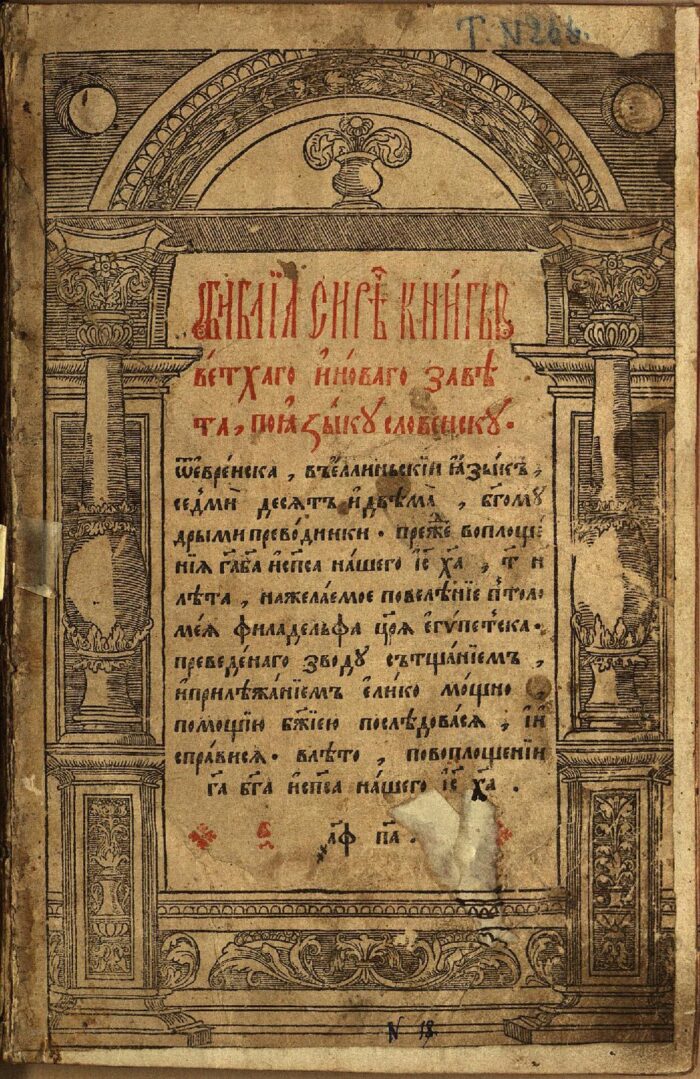
| Title | Ostrog Bible (also Ostroh Bible) |
| Authors | Printing master: Ivan Fedorov Patron: prince Konstantyn Wasyl Ostrogski |
| Date | 1st edition: 12 July 1850 2nd edition: 12 August 1851 |
| Place | Ostrog, Polish-Lithuanian Commonwealth (now: Ostroh, Rivne Oblast, Ukraine) |
| Language | Church Slavonic |
| Source | Physical copy: State Public Scientific & Technological Library, Novosibirsk, Russia Digital copy: Wikimedia Commons |
General info
Ostrog Bible (also “Ostroh Bible” in a different pronunciation) is the first Bible printed fully in Church Slavonic language. The printing master Ivan Fedorov made it by the order and under the patronage of prince Konstantyn Ostrogski. The main source for it was Gennadii’s Bible (1499, Novgorod) and later the Ostrog Bible itself served as a main source for Moscow’s Bible (1663).
For more general info on Ostrog Bible, click here.
Significance
It is difficult to overestimate the historical, cultural, religious and political significance of the Ostrog Bible. From the moment of its publication, it remained the primary book for Orthodox Slavic peoples and their neighboring Orthodox nations for nearly a century. In Eastern Europe it had additionaly served in ideological and educational purposes, resisting the strong influence of Catholic Church there. Copies of the Ostrog Bible could be found in the libraries throughout the whole world, in the collections of university libraries as well as in the personal book collections of famous historical figures of those times.
There is, however, a certain group of people for whom the Ostrog Bible is not simply important, but has a really fundametal meaning. These people are called Old Believers (also called Old Ritualists). This branch of Orthodox Chistianity has appeared after Eastern Orthodox Church reforms were performed by Patriarch of Moscow Nikon and Tsar Alexei Mikhailovich in 1652-1667. In the western historiography these events are known as “The Schism of the Russian Church” or “Raskol”. The goals of those reforms were to change liturgical and ritual practices of Russian Orthodox Church to make them closer to the ones of Greek Orthodox Church. Those who opposed the reforms and maintained their practices the old ways soon became called Old Believers. For Old Believers it were only them who stayed “truly Orthodox Christians”, while the reformed Russian Orthodox Church and its followers in their eyes became “heretics” or even “Anti-Christian Church”, which name and deeds of its priests and followers were assotiated with Antichrist. Russian Orthodox Church along with Russian Tsardom’s authorities responded in the same way, anathematizing and persecuting Old Believers.
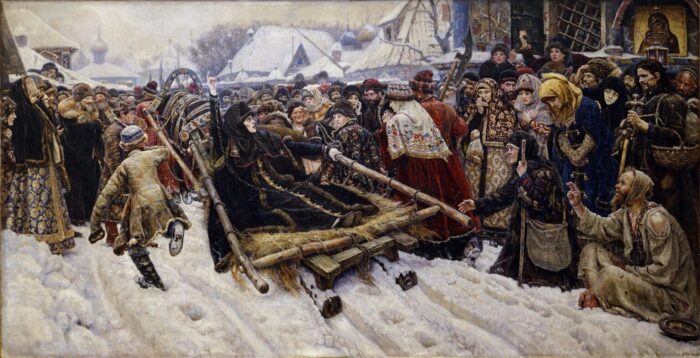
The painting by Vasily Surikov, “Boyaryna Morozova” (“Noblewoman Morozova”), oil on canvas, 1884-1887.
Considered to be one of the most well-known depictions of Raskol in the art.
Saving themselves from repressions, Old Believers often fled into the deep outback or outside the borders of Russia where they lived in closed communities, preserving their rituals and traditions and minimizing contacts with the outer world to highest level possible. Almost each of this community had their own copy of the Bible or at least extracts from it – and, since the Ostrog Bible was the only Bible edition which was widely printed in Church Slavonic before the reforms, it became the only canonical edition of Bible for them.
For today, there are communities of Old Believers around the whole world. In XIX and XX century, when mass migrations became more accessible to ordinary people, some Old Believers’ communities have relocated and settled not only in traditional places of migrants from Russian state, like Europe and North America, but also in South America, Africa, Asia and Australia. Most of these communities are still active today and, despite having not so closed and self-contained ways of life which they had years ago, they are still preserving their rituals, their traditions, their culture – and their Bibles as well, most of which are copies of Ostrog Bible.
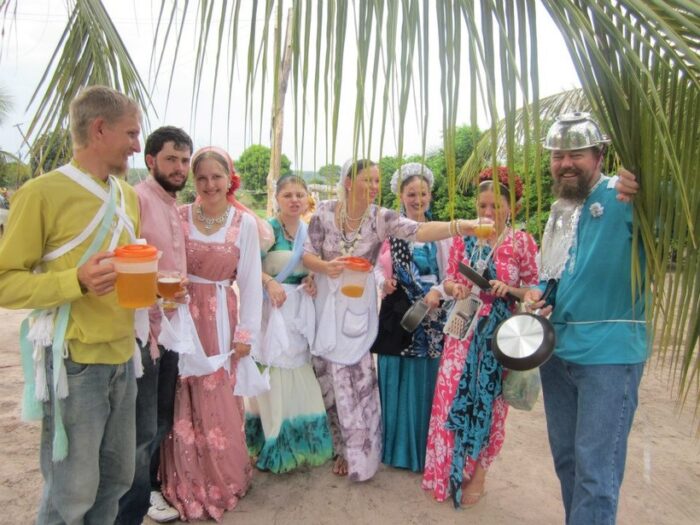
A group of Old Believers in Toborochi, Bolivia.
Source: https://travelask.ru/blog/posts/12037-staroobryadtsy-v-bolivii-kak-v-yuzhnoamerikanskoy-strane-oka
A collective photo of church congregation of Old Believers’ Church in Sydney, Australia.
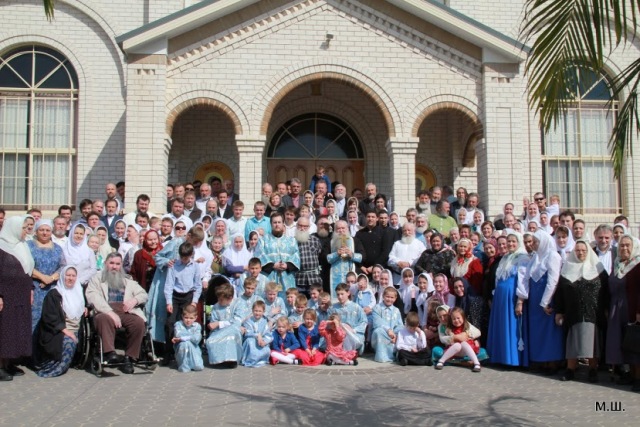
Rewieved copy
This particular digitized copy comes from the collection of rare books of The Russian National Public Library for Science and Technology (abbreviated GPNTB) in Novosibirsk, Russia. It was a part of personal collection of famous Russian and Soviet historian Mikhail Tikhomirov (1893 – 1965); in his last will he donated them to the library fund.
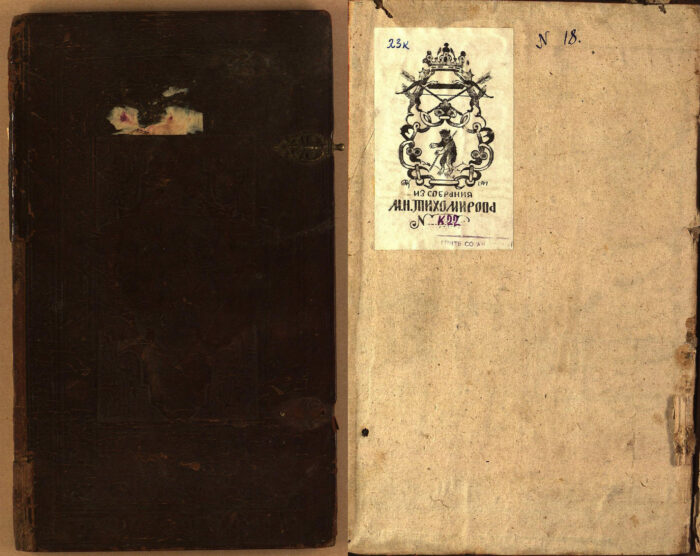
The front cover of the Bible’s copy and M. Tikhomirov’s ex-libris.
Researchers do believe this is one of the copies that were made in 1581. Judging by watermarks on some pages, the paper for them came from local Polish and Lithuanian factories. The binding and the cover, however, were made later, in XIX century. To XIX century also belongs the inscription made on one of the front pages: it testifies the fact that a priest has sold it to a mieshanin (Russian term meaning an ordinary town citizen).
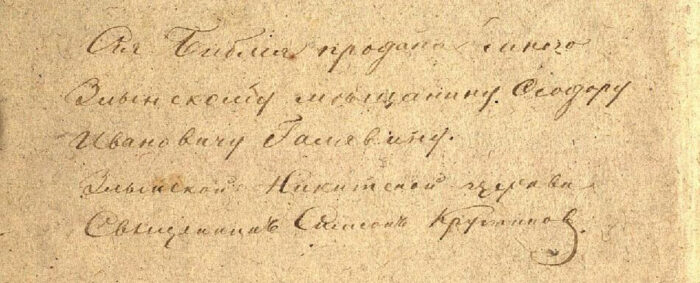
The inscription, translated as: “This Bible was sold by me / to the Zlynsk’s mieshanin Feodor / Ivanovich Galyavin. / Zlynsk’s Nikitian church’s / priest Samson Krutikov.“
With accordance to this and, knowing the fact that M. Tikhomirov started to collect his rare books collection somewhere in 1950’s, we can try to track, at least in particular, the long and the complex path of this particular book to a fund where it is preserved now.
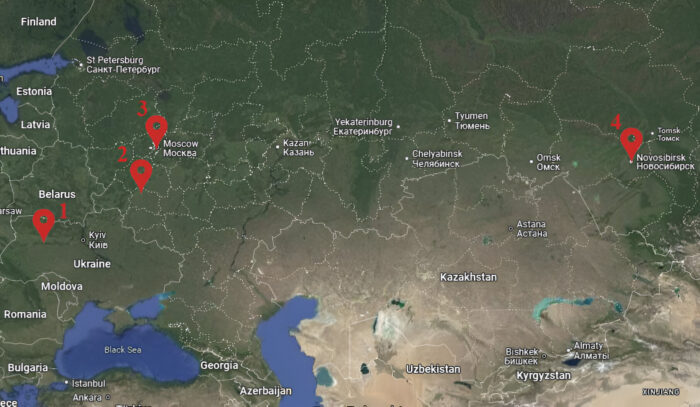
Some key points and places of this copy’s long lifepath : 1 – Ostroh, Polish-Lithuanuan Commonwealth (now Ukraine), where it was printed in 1581 ; 2 – Zlyn, Russian Empire (now Russia), where it was sold in XIX century ; 3 – Moscow, USSR (now Russia), where it was a part of Tikhomirov’s collection circa 1950’s ; 4 – Novosibirsk, USSR (now Russia), where it was sent to in 1965 and where it stays for now.
The copy was digitalized by personnel of Novosibirsk State University (NSU) and published in the Internet without copyrights. The christian volunteers have also made a significant contribution of distribution of this and many other digitalized copies of Bibles through the web.
The Book of Revelation
The Book of Revelation, also known as the The Book of Apocalypse, is the last book of the New Testament in the Bible. It is the only apocalyptic book in the New Testament. Eastern Orthodox Church traditionally attributes its authorship to Saint John the Theologian, more known as John the Apostle in Western traditions, the writer of the Gospel bearing his name. Traditionally, the book is believed to have been written at the end of the I century AD. The book describes events preceding the Second Coming of Jesus Christ to Earth, which, according to earlier recorded prophecies in the Bible, will be accompanied by numerous cataclysms and disasters. Therefore, the word “apocalypse” is often used as a synonym for the end of the world or for a catastrophe of planetary scale. The book also describes the Second Coming of Jesus Christ and the events that follow it.
Chapter 8: transcriptions, translations and comparisons.
In the comparisons below, an original text of Chapter 8 from Ostrog Bible (beginning from Verse 6 to the end) is compared with its more contemporary versions.
And here is also the transcription of same text from Church Slavonic to Latin and its comparison with translation of this text into English (New King James Version of it):
| Transcription to Latin alphabet | English translation (NKJV) |
| I sedm’ Angel, izje imeahu sedm’ trub, ugotovashasya, da vostru- byat. I pervomu Angelu vostru- bivshu, byst’ grad i ogn, sme- sheni s kroviu, i pade na zemly i tretiya chast’ dreva pogore, i vsyaka trava zlachnaya pogore. I vtoriy Angel vostrubi, i yako gora velika ognem zhegoma vverzhena byst’ v more: i byst’ tretiya chast’ morya krov’. I umre tretiya chast’ sozda- nii sushikh v mori, imushikh dushi, i tre- tiya chast’ korablei pogibe. I tre- tii Angel vostrubi, i pade s nebese zvezda velika, goryashi yako svecha, i pade na tretiu chast’ rek i na isto- chniki vodniya: i imya zvesde glagole- tsya apsinoos: i byst’ tretiya chast’ vod yako pelyn’, i mnozi ot chelovek umrosha ot vod, yako gorki be- sha. I chetverii Angel vostru- bi, i uyazvena byst’ tretiya chast’ solntsa i tretiya chast’ luni i tre- tiya chast’ zvezd, da zatmitsya tretiya chast’ ikh, i dne tretiya chast’ da ne svetit, i noch ta- kojde. I videkh i slyshakh edinago Angela pariasha posrede nebese, glagolysha glasom velikim: gore, gore, gore ji- vyshym na zemli ot prochikh glasov trubnikh trekh Angel khotya- shikh trubiti. | So the seven angels who had the seven trumpets prepared them- selves to sound. The first angel soun- ded: And hail and fire followed, ming- led with blood, and they were thrown to the earth. And a third of the trees were burned up, and all green grass was burned up. Then the second Angel sounded: and smth like a great mountain burning with fire was thrown into the sea, and a third of the sea became blood. And a third of the living crea- tures in the sea died, and a thi- rd of the ships were destroyed. Then the thi- rd Angel sounded: And a great star fell from heaven, burning like a torch, and it fell on a third of the rivers and on the spri- ngs of water. The name of the star is Wormwood. A third of the waters became wormwood, and many men died from the water, because it was made bitter. Then the fourth Angel soun- ded: And a third of the sun was struck, a third of the moon, and a thi- rd third of the stars, so that a third of them were darkened. A third of the day day did not shine, and likewise the night. And I looked, and I heard an Angel flying through the midst of heaven, saying with a loud voice: «Woe, woe, woe to the inhabi- tants of the earth, because of the remaining blasts of the trumpet of the three angels who are about to sound!» |
Chapter 8: interpretations and cultural meanings
The Book of Revelation is probably one of the most popular parts of the Bible for various interpretations and readings. The first six seals, mentioned in the Сhapter 6, are believed by most scholars to symbolize wars, epidemics, famine and natural disasters that will await humanity before the Second Coming of Christ. However, according to researchers, they represent types of catastrophes and disasters with which the author’s contemporaries were already familiar very good. The Chapter 7 is placed chronologically after the opening of the sixth seal and before the opening of the seventh one. It is dedicated to all those who will be saved during this period of the Great Tribulation. For everyone else, the nightmare is just beginning – and it starts with the opening of the seventh seal, which occurs at the beginning of Chapter 8 (8:1).
The figures of Angels mentioned later in the text are interpreted in various ways. For example, the “Another Angel” in verses 8:3-4 is sometimes interpreted as Jesus Christ, the God Himself, who has once again descended to earth to bring judgment upon his enemies. The remaining seven Angels also have different interpretations: they are seen as either actual Angels of the Lord, called to assist Christ in carrying out his judgment, or as symbolic representations of impending disasters. However, most scholars agree on one thing: the catastrophes described in Chapter 8, unlike the “catastrophes of the six seals” from Chapter 6, will be truly unimaginable to people – and, therefore, far more terrifying.
Many of these catastrophes are similar to the Plagues of Egypt described in the Old Testament: turning water into blood, fiery hail, darkness during both day and night… But, unlike the Plagues of Egypt, the catastrophes described in Chapter 8 of the Book of Revelation are foretold to be worldwide, more widespread and far more dreadful in their consequences. It should be noted, however, that in this chapter only four of the seven trumpeting Angels are described. The descriptions of the remaining three are found in Chapters 9 and 10, and they appear even more terrifying, as they will not harm people indirectly – through famine, disease and other sorrows that usually accompany natural disasters – but directly, through the torment and suffering of their bodies and souls. It is no coincidence that these last three trumpeting Angels are having their own, separate chapters.
Perhaps the most difficult part of Revelation to interpret are verses 8:10 and 8:11, which speak of the “Wormwood star.” According to the text, it is supposed to fall from the sky and poison a third of the Earth’s waters, making them bitter like wormwood and lethally toxic. A fairly straightforward interpretation is popular among some researchers: they see it as a reference to an asteroid, comet, or other celestial body that will collide with the Earth, causing water contamination through chemical reactions and other catastrophic consequences. Others believe that the “Wormwood star” may represent a historical figure who will bring much suffering to the nations of the world. This interpretation is supported by the fact that in earlier books of the Bible the word “star” sometimes was used to describe people with great power and influence. Finally, there is a point of view that term “Wormwood” is purely symbolic, representing the bitterness and sorrows that will fill the Earth during the time of the Great Tribulation.
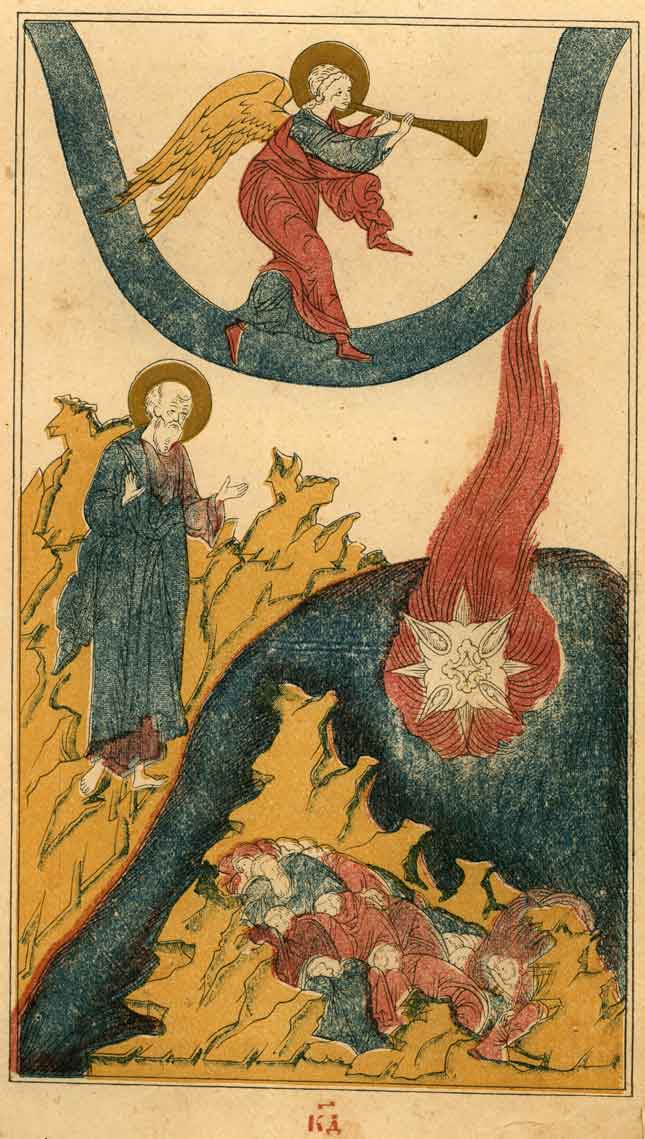
The star Wormwood falls towards the earth.
Old Believer illustration, reprinted in Moscow in 1909, from an ancient written manuscript of the first half of the XVII century.
Probably one of the most unusual theories ties up “Wormwood star” with Chornobyl nuclear disaster that occured on 26 April 1986. The coincidence here is that the word “Chornobylnik” in Ukrainian means one of the names of Wormwood grass, and the name of the Chornobyl city came exactly from this word. This theory has even left a trace in history and culture of contemporary Ukraine: in 2011, 25 years after the disaster, the memorial complex “Wormwood star” was opened in the memory of everyone who suffered this tragedy. It consists of multiple alleys, monuments and sculptures: one of them is the trumpeting Angel.
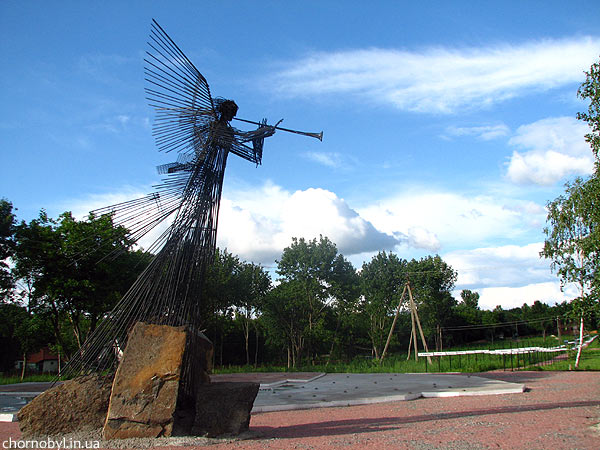
The sculpture of an Angel in the memorial complex “Wormwood star”, Chornobyl, Ukraine.
Source: https://chornobyl.in.ua/chernobyl-zvezda-polyn.html
Bibliorgaphy and sources:
- https://www.spsl.nsc.ru/rbook/%D0%98%D0%B7%D0%B4%D0%B0%D0%BD%D0%B8%D1%8F%20%D0%98%D0%B2%D0%B0%D0%BD%D0%B0%20%D0%A4%D0%B5%D0%B4%D0%BE%D1%80%D0%BE%D0%B2%D0%B0/%D0%9E%D1%81%D1%82%D1%80%D0%BE%D0%B6%D1%81%D0%BA%D0%B0%D1%8F%20%D0%B1%D0%B8%D0%B1%D0%BB%D0%B8%D1%8F/index.html (in Russian)
- https://bibliotekanauki.pl/articles/481719 (in Polish)
- https://www.bibliosphere.ru/jour/article/view/112 (avaliable in Russian and English)
- https://rosa.uniroma1.it/rosa01/ricerche_slavistiche/article/view/2423 (in English)
- https://azbyka.ru/biblia/ (text of Bible avaliable on almost all languages)
- Henry R. Cooper, Slavic Scriptures : the formation of the Church Slavonic version of the Holy Bible, 2003 (https://archive.org/details/slavicscriptures0000coop/page/n9/mode/2up)
- Horace G. Lunt, Old Church Slavonic Grammar, 2001.



